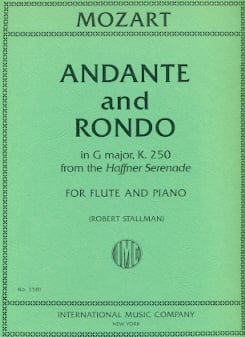Syrinx Music
Mozart - Andante and Rondo, in G major, K. 250 from the Haffner Serenade (STALLMAN, Robert)
Mozart - Andante and Rondo, in G major, K. 250 from the Haffner Serenade (STALLMAN, Robert)
Couldn't load pickup availability
The Haffner Serenade, K. 250 (not to be confused with the Haffner Symphony, K. 385) is an unusually large orchestral work that Mozart composed in Salzburg in July of 1776 for the wedding of the daughter of Sigmund Haffner, a friend of Mozart's father and a prosperous merchant and burgomaster of Salzburg.
Remarkably, the festive eight-movement Serenade encapsulates a violin concerto within its extended form. These concerto movements (the Andante, Rondo and Menuetto I) obviously served as brilliant vehicles for Mozart at the first performance, in which he played violin while leading the orchestra. The Rondo is an absolute tour de force for the soloist and one of the longest of its kind.Ã Yet with all its melodic charm and whirlwind humor, the movement is not one bar too long.
The noted French Mozart scholar Georges Saint-Foix has noted that this Serenade Ã"marks for us the climax, not to say the apotheosis, of the [Mozart] period we have designated as galante. It is the successor of the Serenades of 1773-75, but with what a difference!Ã"
Violinists, for whom Mozart has written so much beautiful music, should not begrudge us flutists for borrowing two of these solo movementsÃ--the Andante and Rondo, both in G major. The affecting cantabile of the Andante is perfectly suited to the flute, in terms of range and character, while the witty virtuosity of the Rondo may even be enhanced by the flute's natural agility and fleetness of articulation.
Like the Andante in C major (K. 315) and Rondo in D major (K. Anh. 184, arranged by Franz Hoffmeister), these marvelous youthful works by Mozart will, I hope, soon become staples of our concerto repertoire and an added source of pleasure and inspiration for us all.
Share


